Uranus is a most unusual planet. Aside from being the seventh planet of our Solar System and the third gas giant, it is also classified sometimes as an “ice giant” (along with Neptune). This is because of its peculiar chemical composition, where water and other volatiles (i.e. ammonia, methane, and other hydrocarbons) in its atmosphere are compressed to the point where they become solid.
Finite Light - Why we always look back in time
What is the color of Pluto?
When Pluto was first discovered by Clybe Tombaugh in 1930, astronomers believed that they had found the ninth and outermost planet of the Solar System. In the decades that followed, what little we were able to learn about this distant world was the product of surveys conducted using Earth-based telescopes. Throughout this period, astronomers believed that Pluto was a dirty brown color.
What is an astronomical unit?
When it comes to dealing with the cosmos, we humans like to couch things in familiar terms. When examining exoplanets, we classify them based on their similarities to the planets in our own Solar System – i.e. terrestrial, gas giant, Earth-size, Jupiter-sized, Neptune-sized, etc. And when measuring astronomical distances, we do much the same.
Watch stars orbit Milky Ways supermassive black hole
When your ordinary citizen learns there’s a supermassive black hole with a mass of 4 million suns sucking on its teeth in the center of the Milky Way galaxy, they might kindly ask exactly how astronomers know this. A perfectly legitimate question. You can tell them that the laws of physics guarantee their existence or that people have been thinking about black holes since 1783. That year, English clergyman John Michell proposed the idea of “dark stars” so massive and gravitationally powerful they could imprison their own light.
Why Doesn't Earth Have Rings?
Before we really get started on today’s episode, I’d like to share a bunch of really cool pictures created by my friend Kevin Gill. Kevin’s a computer programmer, 3-D animator and works on climate science data for NASA. And in his spare time, he uses his skills to help him imagine what the Universe could look like. For example, he’s mapped out what a future terraformed Mars might look like based on elevation maps, or rendered moons disturbing Saturn’s rings with their gravity.
Eye opening numbers on space debris
Orbital debris, otherwise known as “space junk”, is a major concern. This massive cloud that orbits the Earth is the result of the many satellites, platforms and spent launchers that have been sent into space over the years. And as time went on, collisions between these objects (as well as disintegrations and erosion) has created even more in the way of debris.
Ever wondered what final approach to Mars might feel like?
We’ve posted several ‘flyover’ videos of Mars that use data from spacecraft. But this video might be the most spectacular and realistic. Created by filmmaker Jan Fröjdman from Finland, “A Fictive Flight Above Real Mars” uses actual data from the venerable HiRISE camera on board the Mars Reconnaissance Orbiter, and takes you on a 3-D tour over steep cliffs, high buttes, amazing craters, polygons and other remarkable land forms. But Fröjdman also adds a few features reminiscent of the landing videos taken by the Apollo astronauts. Complete with crosshatches and thruster firings, this video puts you on final approach to land on (and then take off from) Mars’ surface.
How did Uranus get its name?
The period known as the Scientific Revolution (ca. 16th to the 18th century) was a time of major scientific upheaval. In addition to advances made in mathematics, chemistry, and the natural sciences, several major discoveries were made in the field of astronomy. Because of this, our understanding of the size and structure of the Solar System was forever revolutionized.
Hubble's Glittering Frisbee Galaxy
This image from Hubble’s Wide Field Camera 3 (WFC3) shows a section of NGC 1448, a spiral galaxy located about 50 million light-years from Earth in the little-known constellation of Horologium (The Pendulum Clock). We tend to think of spiral galaxies as massive and roughly circular celestial bodies, so this glittering oval does not immediately appear to fit the visual bill. What’s going on?
Does Mars Have Rings? Not Right Now, But Maybe One Day
How far is Venus from the Sun?
Earth and Venus are often called “sister planets” because they share some key characteristics. Like Earth, Venus is a terrestrial planet (i.e. composed of silicate minerals and metals) and orbits within our Sun’s habitable zone. But of course, they are also some major differences between them, like the fact that Venus’ is atmosphere is extremely dense and the hottest in the Solar System.
Life on Earth is used to gravity – so what happens to our cells and tissues in space?
There’s one force whose effects are so deeply entrenched in our everyday lives that we probably don’t think much about it at all: gravity. Gravity is the force that causes attraction between masses. It’s why when you drop a pen, it falls to the ground. But because gravitational force is proportional to the mass of the object, only large objects like planets create tangible attractions. This is why the study of gravity traditionally focused on massive objects like planets.
Fried egg? Flying saucer? Nope. Just cool closeups of Saturn's moon Pan
Besides Earth, Saturn may be the only other planet where you can order rings with a side of ravioli. Closeup photos taken by the Cassini probe of the the planet’s second-innermost moon, Pan, on March 7 reveal remarkable new details that have us grasping at food analogies in a feeble attempt to describe its unique appearance.
How long is a day on Mercury
Mercury is one of the most unusual planets in our Solar System, at least by the standards of us privileged Earthlings. Despite being the closest planet to our Sun, it is not the hottest (that honor goes to Venus). And because of its virtually non-existence atmosphere and slow rotation, temperatures on its surface range from being extremely hot to extremely cold.
Comets or volcanoes? Scientists are changing their minds about how the Earth’s water got here
The Earth has been the blue planet for as many as 3.8 billion years. Ancient sedimentary rock deposits and lava that cooled into characteristic pillow shapes provide irrefutable evidence that liquid water has existed at the Earth’s surface for at least this long. But given how many barren rocks there are in the galaxy, Earth’s abundant oceans raise the question of where all that water came from.
When galaxies collide, stars suffer the consequences
When galaxies collide, the result is nothing short of spectacular. While this type of event only takes place once every few billion years (and takes millions of years to complete), it is actually pretty common from a cosmological perspective. And interestingly enough, one of the most impressive consequences – stars being ripped apart by supermassive black holes (SMBHs) – is quite common as well.
A Galaxy on the Edge
This colourful stripe of stars, gas, and dust is actually a spiral galaxy named NGC 1055. Captured here by ESO’s Very Large Telescope (VLT), this big galaxy is thought to be up to 15 percent larger in diameter than the Milky Way. NGC 1055 appears to lack the whirling arms characteristic of a spiral, as it is seen edge-on. However, it displays odd twists in its structure that were probably caused by an interaction with a large neighbouring galaxy.
How far is Mercury from the sun?
Mercury is famously known for being a scorching hot world. On the side that is facing towards the Sun, conditions can get pretty molten, reaching temperatures of up to 700 K (427 °C; 800°F) in the equatorial region. The surface is also airless, in part because any atmosphere it could generate would be blown away by solar wind. Hardly surprising, considering it is the closest planet to our Sun.
The search for extraterrestrial life in the water worlds close to home
The discovery of seven exoplanets around a star 40 light years from our Sun has raised the possibility that they could harbour life. Why? Because the astronomers who made the discovery believe some of the planets may have liquid water. And on Earth, wherever there is liquid water, there is life. But we believe we can look much closer to Earth







